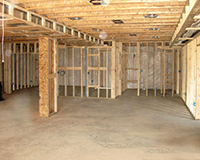 As residential property prices in central London go through the roof, the market has responded by literally going underground. The surge in homeowners creating new space by constructing or enlarging basements has generated huge controversy because of the associated construction noise and disturbance, and because of fears over potential physical damage to neighbouring properties. Often these basement developments take place in areas where space is at a premium or where properties may be listed and conservation area issues may be involved. Surprisingly, the legality of these developments has been far from clear, especially as there is an absence of technical planning guidance, but a recent Planning Court case has now provided some welcome clarity in relation to permitted development rights.
As residential property prices in central London go through the roof, the market has responded by literally going underground. The surge in homeowners creating new space by constructing or enlarging basements has generated huge controversy because of the associated construction noise and disturbance, and because of fears over potential physical damage to neighbouring properties. Often these basement developments take place in areas where space is at a premium or where properties may be listed and conservation area issues may be involved. Surprisingly, the legality of these developments has been far from clear, especially as there is an absence of technical planning guidance, but a recent Planning Court case has now provided some welcome clarity in relation to permitted development rights.
Permitted development
No specific provision is made for basement developments in the Town and Country Planning (General Permitted Development) (England) Order 2015 (or its 1995 predecessor) but many planning authorities have treated basement developments as benefiting from permitted development rights under Class A as works for “the enlargement, improvement or other alteration of a dwellinghouse”. This has the distinct advantage of avoiding the need for a specific planning application that might meet with local plan policy objections.
In Kensington & Chelsea Royal Borough Council v Secretary of State for Communities and Local Government, decided on 17 June but with no transcript yet available, Patterson J ruled on a number of important issues arising under Part 1 Class A of Schedule 2 to the 1995 Order. The council as planning authority was seeking to challenge two inspectors’ appeal decisions granting lawful development certificates in relation to basement developments at Princes Gate Mews and Colbeck Mews. Both involved the addition of a single-story basement to an existing dwelling, with no part extending beyond the perimeter of the existing dwelling. However, permitted development rights are expressly excluded by paragraph A.1(f)(ii) of the 1995 Order where “the enlarged part of the dwellinghouse would have more than one storey and… be within seven metres of any boundary of the curtilage of the dwellinghouse opposite the rear wall of the dwellinghouse”. It is worth noting that the corresponding provision in the 2015 Order is effectively no different.
The council and the secretary of state agreed that permitted development rights in question apply to development above and below ground. However, the main questions the court had to consider were:
• whether the “enlarged part” of the dwellinghouse is simply the single-storey basement, as the secretary of state argued, or whether it includes the existing storeys within the dwellinghouse to which the basement was added, as the council contended; and
• whether the seven-metre restriction should be measured from any dwellinghouse opposite the one being developed (as the inspector on the Princes Gate Mews had decided based on the wording “the dwellinghouse opposite”) or from the dwellinghouse being developed, as the council argued.
The single-storey solution
In the end, the secretary of state conceded the case with regard to the seven metre restriction and so it was agreed (and the judge held) that the restriction throughout paragraph A.1f(ii) is to be measured from the dwellinghouse being extended. However the secretary of state maintained that both inspectors’ decisions were correct, albeit not on the basis of their reasons. Instead it was argued that “the enlarged part of the dwellinghouse” referred solely to the development being added by way of permitted development rights with the consequence that the development did not have “more than one storey”. Patterson J agreed. She dismissed the council’s challenges and upheld the grant of the lawful development certificates despite the errors in the inspectors’ decision letters.
The basement battle is only beginning
This judgment is important and those wishing to promote basement developments will seize on it. However, it does have its limitations in terms of its scope. With permitted development rights, the devil is in the detail. Unless a development proposal falls squarely within the four corners of the relevant permitted development right then a planning application will usually be required. If so, then any relevant local planning policy will be important. Consequently this judgment may not be the last word. By publication of this planning note, the Planning Court should have heard a legal challenge to the adoption by the council of its basement policy, to be found in its Core Strategy policy CL7. The full council adopted this detailed policy on 21 January 2015 and the explanatory text outlines the main problems associated with this form of development in its area. Later, on 27 October 2015, the Planning Court is due to hear another challenge by the council to an inspector’s decision in relation to a grant of planning permission in Egerton Crescent as an exception to the recently adopted policy.
It seems that one battle may have been won by homeowners but, as the BBC termed it, the “millionaires’ basement wars” rumble on.







